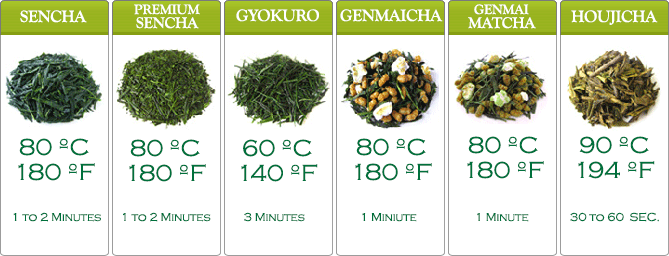How to Brew & Storage Japanese Green Tea
There are fundamentally two methods of making Japanese green tea. First is the traditional way, of which there are numerous variations. Many people consider the traditional way to be time consuming and somewhat difficult. Various other web sites and instructional guides are devoted to this method.
Second is the practical way. While many Japanese homes and offices will revert to the traditional way when serving guests or on special occasions, in their daily life they use the practical way because they want to enjoy drinking green tea as conveniently as possible. Below we present our explanation of the practical way.
How to Brew our Loose Leaf Teas
There are two important things to consider when brewing our loose leaf green teas. During processing, Japanese green tea is first steamed and not heat-treated. The result is that Japanese green tea can be brewed for full flavor using a lower water temperature and less time than other teas. Next, brewing a pot of Japanese loose leaf green tea is not difficult at all. With some experience, and a little trial and error, it becomes as routine and easy.
Water Quality
The taste of our loose leaf teas is generally mild and not overpowering. If your tap water tastes bad, then so probably will your green tea. We recommend fresh, filtered, or bottled water without a lot of minerals for the best tasting tea.
How Much Green Tea
One teaspoonful (two grams) per person or cup is sufficient. However, depending on your own taste, use as much tea as suits you. After gaining brewing experience, it won't be necessary to actually measure the quantity.
The Teapot
The best method is to use a Japanese Teapot (Kyusu), or just a teapot that has a removable metal basket in which to place the tea. Many of the Japanese Teapots (Kyusu) utilizes a metal strainer that covers the spout on the inside of the teapot. The tea leaves are placed directly inside this type of pot.
Using a tea ball will result in good tasting green tea, but typically it is too small to allow the tea leaves to properly expand during infusion. This restricts bringing out full flavor. New innovatively designed infusion devices are also available. All should work well with loose leaf Japanese green tea.
Heating the Water
Heat as much water as needed for the green tea you desire to drink. Many purists state it is necessary to bring the water to a boil for the best taste. We won't dispute that, but we can't taste the difference compared to when the water is not brought to a boil. For water heating purposes, either a kettle or microwave oven is fine. Nowadays, many Japanese homes and offices use an electric water dispenser, in which the temperature is set at a constant degree.
Infusion Water Temperature
This will vary according to the variety of the green tea (please refer to tea images below). If the water has reached boiling point, then let it cool a few minutes, or add cooler water to bring the temperature down. Feel free to use a thermometer to accurately gauge the water temperature. But again, experience will play a role in your decision.
Infusion Time
This will also vary with each green tea variety and your taste (please refer to tea images below). Please do not swirl or shake the teapot to speed up infusion because this may adversely effect the brew's taste. Then gently pour the brew into your cup.

Other Notes
Japanese green tea will usually not taste bitter. If a more astringent taste is desired, then increase the amount brewed, water temperature and brewing time. Conversely, if your brew tastes too bitter, then reduce the aforementioned factors. Loose leaf green tea may be infused more than once depending on your taste. We recommend three times as the maximum. Use the same temperature water, but the brewing time is only a few seconds. You can significantly reduce the caffeine in green tea by discarding the liquid from the first infusion.
How to Serve Our Loose Leaf Teas
Without question, it is much more aesthetically pleasing to serve Japanese green tea the traditional way. But in everyday life, Japanese green tea is just as tasty in no matter what cup or mug you choose to drink it. If you wish to add a dairy product or sweetener to your brew, then that is entirely up to you. We encourage you to drink Japanese green tea in the manner that will most enhance your enjoyment. The tea leaf residue found in the bottom of your cup is absolutely healthy. One important cultural note is that when you are served green tea by a Japanese person, especially if you are in their home or in Japan, then please do as they do.
How to Store Our Loose Leaf Teas
After packaging, our loose leaf teas will remain fresh for up to two years. Before opening the package, the freshness can be prolonged by putting the package in your refrigerator or freezer. After opening the package, place it in an airtight, tightly sealed container, away from direct sunlight and heat. Please do not put it back into the refrigerator or freezer.
How to Brew our Teabags
Brewing our teabags is as convenient and easy as any other tea. Please pay attention to the water temperature and infusion time, which are the same as for the corresponding loose leaf tea.
Finally, there really is no one correct way to brew Japanese green tea. The best way to brew it is in such a manner that it tastes best to you. Please enjoy your tea.

